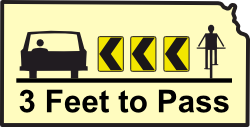 On April 1st, the Kansas House and Senate approved the 3-foot passing/dead red bill, which now moves on to Governor Sam Brownback for his signature.
On April 1st, the Kansas House and Senate approved the 3-foot passing/dead red bill, which now moves on to Governor Sam Brownback for his signature.
No fooling.
On Friday, just before breaking for a three-week holiday following a stressful and contentious budget debate, the members of the House and Senate voted to concur with a conference committee report on HB2192.
The House vote was 107-13. The Senate vote was 23-14.
In the final version of the bill, the bicycle provisions apparently garnered little attention. The controversy was reserved for the provision which would allow the Kansas secretary of transportation to raise the speed limit up to 75 MPH on divided, four-lane highways, which could apply to over 1000 miles of roadway, mostly interstates and about 10 percent of the total highway miles in Kansas.
In a way, it would have been nice to have the 3-foot passing provision fully debated in both chambers, because raising public awareness about the problem of unsafe passing is a big part of the value of the law. On the other hand, having it slide through the legislature unmolested has value as well.
In the end, making 3-foot minimum passing distance Kansas law is the most important thing.
To do that, the bill needs the governor’s signature. If you’d like to send a short message of support to Gov. Brownback at governor@ks.gov, or call his office at 877-579-6757.
According to Kansas.com, “The measure goes next to Gov. Sam Brownback. He hasn’t publicly taken a position on it, and his spokeswoman said only that he’d study it carefully. If he signs it, the changes will take effect July 1.”
Here is the relevant bicycle-related text in the bill:
Section 1. K.S.A. 8-1508 (4) The driver of a motorcycle or a person riding a bicycle facing any steady red signal, which fails to change to a green light within a reasonable period of time because of a signal malfunction or because the signal has failed to detect the arrival of the motorcycle or bicycle because of its size or weight, shall have the right to proceed subject to the rules stated herein. After stopping, the driver or rider shall yield the right-of-way to any vehicle in or near the intersection or approaching on a roadway so closely as to constitute an immediate hazard during the time such driver or rider is moving across or within the intersection or junction of roadways. Such motorcycle or bicycle traffic shall yield the right-of-way to pedestrians lawfully within an adjacent crosswalk and to other traffic lawfully using the intersection.
Sec. 2. K.S.A. 8-1516 (c) (1) The driver of a vehicle overtaking a bicycle proceeding in the same direction shall pass to the left thereof at a distance of not less than three feet and shall not again drive to the right side of the roadway until safely clear of the overtaken bicycle.
(2) The driver of a vehicle may pass a bicycle proceeding in the same direction in a no-passing zone with the duty to execute the pass only when it is safe to do so.
You can read more about Kansas House Bill 2192 here and read the full text of the bill here.
Here’s how CJOnline describes the bill:
The bill also allows motorcycles and bicycles to go through a red light if it has failed to change to green within a reasonable period. The cyclists still must obey all other traffic laws governing right of way.
ABATE of Kansas proposed the “dead red” provisions of the bill for motorcycles, and the House Transportation Committee added bicycles. Motorcycle riders testified during legislative hearings that they occasionally become backed up at red lights because some cycles aren’t heavy enough, or don’t have enough metal mass, to trip sensors that tell the light when to change from red to green.
Bicyclists’ safety came into play in another section of the bill that requires vehicles overtaking bicycles to pass on the left no less than 3 feet from the bicycle. The law allows vehicles to pass bicycles in a no-passing zone only when it is safe to do so.
Preliminary coverage from around the state:
- Lawrence Journal-World: Lawmakers approve bill boosting speed limit on some Kansas highways to 75
- Topeka Capital-Journal: Higher speed limit on fast track
- Wichita Eagle: Kansas lawmakers vote to increase speed limit
Post tags: 3-Foot Passing, Dead Red



I think this is a terrible bill. I have been a cyclist for over 20 years. I believe we settled for far too little. It should be at least 5 feet. Why can’t vehicles pass a bike in the other lane, as one would a larger motorized vehicle?
How many people would like to stand in the road holding a yard stick and be passed by a large vehicle, like a tractor trailer rig or a large pickup and stock trailer, or any vehicle for that matter, and be passed by the vehicle at a high rate of speed just clearing the yardstick?
If a cyclist is passed by two feet, and it is disputed by the driver, even if it is witnessed by a policeman, or others, who will get the benefit of the doubt? In our car-centric society it is most often the car or vehicle. Just look at how many times charges get reduced in bike accidents even when the driver is at fault.
With all due respect to all the great law enforcement people, I’ve seen several give the benefit of the doubt to the motorized vehcile. Although the 3 foot law gives them a firm rule to work with, some judgement will come into play. Three feet is not enough distance in many cases.
I agree that 5 feet would be better, but considering that Kansas had NO statute on the books 3ft is better that zero.
The main purpose of the statute is to help educate the public that they need to give cyclist some distance when passing. This statute gives an easy way for law enforcement to inform the public what a safe passing distance should be.
Currently there are very few states that have laws that are greater than 3ft, but 19 states have 3ft laws.
We have to start somewhere and 3ft is a good start.
Unfortunately, some of the worst violators of this yet-to-take effect law are bicyclists. The law reads that the “driver of a vehicle” overtaking a bicycle must allow three feet. Under Kansas law, a bicycle is a vehicle. Thus, a bicycle passing another bicycle should allow three feet. Also, groups riding together who don’t ride single-file may not allow sufficient space on the roadway for a vehicle to pass with the required three feet. Until these few bicyclists learn to ride more respectfully of others, these laws may serve more to antagonize drivers than to protect bicyclists.
I’m not a cyclist and I have to say that 3 feet seems like way too little. I agree that perhaps it is a good first step. But when it comes to safety I always allow way more than 3 feet. That almost seems silly.